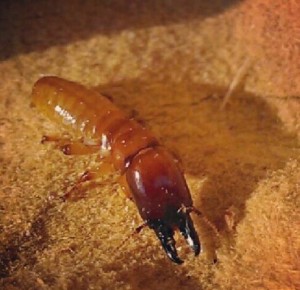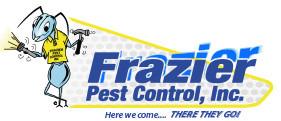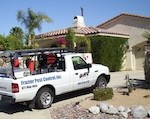Termites In The Desert
SUBTERRANEAN TERMITES
The most destructive types are those that can thrive in urban areas, build large colonies, and their nests being deep underground, can’t be seen and are hard to detect.
Subterranean termites live in underground colonies or in moist secluded areas aboveground that can contain up to 2 million members. Termite colonies are organized depending on tasks — workers, soldiers and reproductive’s. Subterranean termites swarm in the spring — groups of reproductive termites go off to start new colonies.

Subterranean termites live underground and build tunnels, referred to as mud tubes, to reach food sources, and to protect themselves from open air. From their underground nests, tunnels radiate out in all directions, through which these subterranean termites forage for sources of wood. Subterranean termites need contact with the soil to survive and live underground, and can build tunnels through cracks in concrete.
A common trait of subterranean termites is their habit of building shelter tubes when they have to venture over exposed areas. They allow the termites to cross exposed surfaces without getting seen, as well as protect them from desiccation. Their underground habits mean that many species have evolved in a pale color, often leading people to refer to them as “white ants.”
Like other termite species, they feed on products containing cellulose, however, unlike other species, they produce liquid feces.
Signs of Infestation
Interior damage may not become apparent until infestations are full-blown. Termite damage sometimes appears similar to water damage. Outward signs of termite damage include buckling wood, swollen floors and ceilings, areas that appear to be suffering from slight water damage and visible mazes within walls or furniture. Termite infestations also can exude a scent similar to mildew or mold. Subterranean termites also access aboveground food sources through mud tunnels they create from saliva, mud and feces. These tunnels are located near the foundation of infested homes. Mud tubes are noticeable in heavy infestations. Brown soil accumulation can be seen in certain settings.
Characteristics of Damaged Wood
Generally, the most frequently damaged parts of a building (if attacked by subterranean termites) include parts like door and window frames, wooden skirts, wooden floors, wall paneling, and wooden furnishings like cabinets and cupboards that are located close to, or touching a wall. In heavy infestations, subterranean termites can and will attack wooden roofing, as well as paper and cardboard stacks (books and boxes), and sometimes bite through wiring in the wall. Subterranean termites typically follow the grain of the wood, feeding primarily on the soft spring wood. The hard, saw-toothed jaws of termites work like shears and are able to bite off extremely small fragments of wood, one piece at a time. Subterranean termites create a distinctive honeycomb pattern in damaged wood, forming tunnels inside the softer spring wood and leaving the external grain intact. Seriously damaged wood breaks easily to show the inside of mud- or soil-filled termite galleries.
DRYWOOD TERMITES
Drywood termites are social insects that live in colonies in sound, dry wood. Each colony consists of offspring from an original pair (male and female). There are three growth stages – eggs, immatures and adults. Drywood termites are larger than local, southwestern subterranean species. Most colonies remain small, but multiple colonies in the same piece of wood may contain up to 10,000 individuals. The importance of a thorough inspection for drywood termites and their damage cannot be overemphasized, since the various control measures so closely relate to the extent of infestation and the amount of damage.
Signs of Infestation
Generally, the first indirect sign of infestation is the discovery of fecal pellets or the presence of alates (winged reproductive) on windowsills or near lights. Alates found inside the house (if windows and doors have been closed), are an indication of infestation within the structure. Another indication of infestation is the presence of discarded wings near emergence sites, on windowsills or caught up in cobwebs. The presence of alates outdoors is a natural phenomenon and is not an implication of home infestation. Drywood termites spend their entire lives inside wood. They construct round “kick holes” in infested wood, through which the fecal pellets are eliminated from the galleries or tunnels. These pellets accumulate in small piles below the kick holes and also may be found caught in spider webs. Fecal pellets are distinctive and used for identification of drywood termite infestation. Drywood fecal pellets are hard, elongated and less than 1/25 inch long. Typically the pellets are a light tan in color with some black ones mixed in. A sign of advanced infestation is surface blistering that can be probed with a sharp screwdriver. Remove all potential sources of outdoor infestation such as stored lumber and dead trees or woody shrubbery.
Characteristics of Damaged Wood
Drywood termite damage seldom can be observed on the wood surface; however, sometimes painted wooden surfaces will look blistered if termites have tunneled close to the surface. Wood, which has a dull or hollow sound when tapped, should be examined closely. Careful probing of wood with a sharp instrument may disclose drywood termite galleries. The interior of infested wood contains chambers connected by galleries or tunnels that cut across the wood grain. The galleries have a smooth, sculptured appearance and contain few if any fecal pellets. Accumulations of pellets sometimes may be found in blind galleries or unused tunnels. Drywood termites tend to cut across wood grain destroying both the soft spring wood and the harder summer growth.
In nature, termites function as decomposers that breakdown dead wood that accumulates in and on the soil.
Drywood and Subterranean termites are the most destructive insect pests of wood. Thorough inspections are necessary to confirm termite infestations, assess the extent of damage and determine whether remedial control measures are necessary. Reliable insect identification is imperative. Thorough sounding and probing is necessary to pinpoint the location and extent of infestations. Termite inspectors issue a report outlining potential threats for future infestation.
Corrective Recommendations:
Control measures include reducing the potential for termite infestations, preventing termite entry, removal of infested wood and applying chemicals for remedial treatment.
Wood Replacement, Fumigation, Whole-Structure Treatment, Localized or Spot Treatments.

 Frazier Pest Control is family owned-and-Locally operated. We are licensed, bonded and insured. Serving The Pest….
Frazier Pest Control is family owned-and-Locally operated. We are licensed, bonded and insured. Serving The Pest….